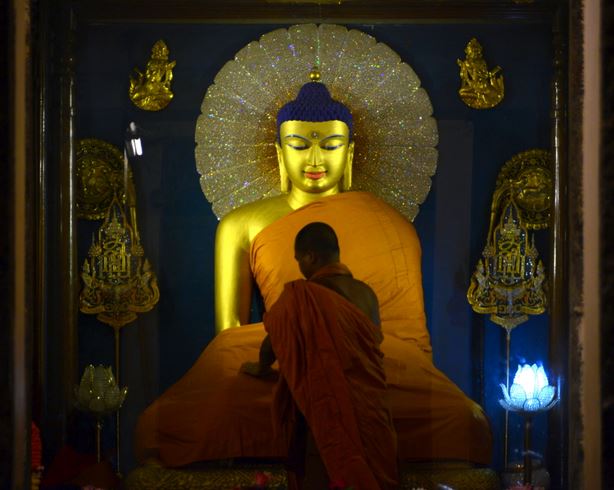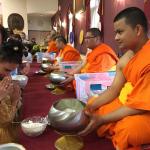Nearly every week I encounter the idea that Buddhism should somehow be kept ‘pure’ and separate from our ordinary, mundane lives. For many, it seems, Buddhism must exist in an ethereal realm apart from the mess and muck of relationships, jobs, politics, the environment, etc, etc. Generally this seems to come from people who have lived comfortable lives of privilege. Buddhism for them is a little additional pillow of comfort.
Part of this is likely due to the romanticization of modernist Buddhism. This “Buddhism” is largely a product of well-off, comfortable white men, “discovered” in ancient texts (the way Columbus “discovered” America). In contrast to these pure texts, ordinary people practicing Buddhism have been seen as disappointing, purveyors of “superstition” that must have been imported later, or “cultural accretions” that could be safely peeled away to give way to something truer.
Another part of this is likely the ‘disembodied’ nature of many individuals today. How many of us work the soil where our vegetables are grown, or care for birthing livestock that provide our meat or dairy. We can, provided enough money, float like gods through the world (at least while we’re young). And yet again this applies most clearly to folks like me: white, male, at the moment financially comfortable. If I hadn’t been exposed to (and listened to) countless women, I might not know that few women feel this freedom. Recent abortion laws underscore this for some. Special restrictions put on women: women driving, women wearing certain clothes, the policing of women’s hair, the unfair scrutiny of women in politics on down throughout the whole workforce. People of color too face daily reminders in their own lives and in the news, reminders that the world has a hold on them.

For those of us free of such added burdens, Buddhism can help challenge our ‘god-like’ floating ignorance of this suffering around us. But that takes work. And it takes getting into uncomfortable spaces. But if we are serious about practicing Buddhism, instead of merely placing it delicately on our mantle this is the work we must do. In this practice, we inevitably come into contact with others, with their perspectives, their sufferings (structural, individual, etc), and as Buddhism teaches that ultimately, suffering is suffering, we engage in the work of alleviating that suffering and understanding those perspectives.
William Edelglass offers a compelling discussion of this practice, setting perspectives of Buddhism into conversation with Western philosophy:
“Buddhism offers a vast tradition of philosophical and moral reflection. But traditions endure only to the degree to which they address the experience and concerns of each new generation. Our contemporary concerns include justice and inequality, navigating difference in multicultural societies, climate change, and the pervasiveness of information technology. Discerning how to speak, act, and think skillfully in our contemporary context requires us to engage with these concerns. As Buddhists, we should not be afraid of drawing on Western thought when it can help with this engagement.”
Any “Buddhism” kept separate from contemporary concerns will be like a delicate flower transported to an unsuitable environment, attractive, but stripped of context, meaning, and purpose – and with an inevitably short life.
But the discussion must go both ways: not just applying Buddhist wisdom to our contemporary concerns, but also allowing Buddhism to critique those concerns. Edelglass writes:
To appreciate the ways classical Buddhist texts can challenge our thinking, we should be aware of the interpretive frameworks through which we encounter them. For many of us, that means the cultural and philosophical orientations of Western modernity. Western thought can help us understand why we might find appealing a form of Buddhism that de-emphasizes tradition, mythology, and ritual and valorizes psychology, creativity, nature, social engagement, and the affirmation of this life and the present moment. Classical Buddhist texts speak to us from outside our own discourse and challenge us to think differently; if we don’t understand our interpretive frameworks, however, we may just see a projection of our own creation.
For Buddhism to work, it must work in people, in our frameworks, in our lives. But for Buddhism to work it must be understood: historically, contextually, critically, carefully. This is the dialectic, the discussion. For the idealized “scholar” there is no personal life brought to Buddhism. What is found and examined and understood is as lifeless and cold as a cadaver. For the overly naive practitioner, Buddhism is twisted into the “projection” Edelglass mentions. Sometimes the scholar encounters the naive beginner and, having failed to live even an ounce of the subject matter, pounce with scorn on the naivete and misunderstandings of the human being before them.
Somewhere the two ends of the discussion must meet, often slowly but surely. The scholar “discovers” that some of this is actually meaningful, or correct, or useful in their life, perhaps humbling them to sit beside the newcomer in meditation or at a retreat. The newcomer likewise must realize that Buddhism has existed for 2500 years outside of their head – in the lives of other people. Perhaps, having calmed some of their own mental wanderings, they can sit down and read a book, compare notes of scholar, examine some source material, etc. The two come together. Perhaps the experiential insights of the practitioner can be used to guide the scholar in their own journey of introspection, just as much as the historical and schematic data from the scholar can help guide the student.
please join our community of patrons for $1/month













